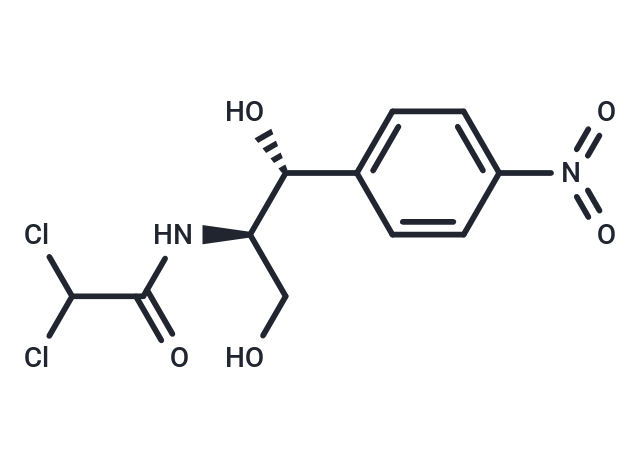Shopping Cart
- Remove All
 Your shopping cart is currently empty
Your shopping cart is currently empty

Chloramphenicol (Chloromycetin) is a broad-spectrum antibiotic that inhibits the biosynthesis of bacterial proteins. Chloramphenicol acts primarily on the 50S subunit of the bacterial 70S ribosome and is active against peptidyltransferases, inhibiting the formation of peptide bonds.

| Pack Size | Price | Availability | Quantity |
|---|---|---|---|
| 500 mg | $40 | In Stock | |
| 1 g | $48 | In Stock | |
| 5 g | $64 | In Stock | |
| 10 g | $93 | In Stock |
| Description | Chloramphenicol (Chloromycetin) is a broad-spectrum antibiotic that inhibits the biosynthesis of bacterial proteins. Chloramphenicol acts primarily on the 50S subunit of the bacterial 70S ribosome and is active against peptidyltransferases, inhibiting the formation of peptide bonds. |
| In vitro | METHODS: Human lung cancer cells A549 and H1299 were treated with Chloramphenicol (1-100 µg/mL) for 3-24 h. Cell viability was detected by MTT assay. RESULTS: In the 3 h treatment group, the viability of A549 and H1299 cells at 100 µg/mL was 97.0±3.9% and 98.1±5.0%, respectively, and no cytotoxicity was observed. A significant reduction in cell viability was observed in the 24 h treatment group. [1] METHODS: Mouse T cell lines A1.1 and IE5 and human T cell lines Jurkat and Jcam were stimulated with Chloramphenicol (100 nmol/L), and the DNA content was measured by Flow cytometry. RESULTS: Chloramphenicol clearly blocked activation-induced cell death (AICD) in all four cell lines, even though these cells were activated by different stimuli. [2] |
| In vivo | METHODS: To investigate the potential to induce aplastic anemia, Chloramphenicol (2000 mg/kg) and Thiamphenicol (850 mg/kg) were administered by gavage to BALB/c mice once daily for 17 days. RESULTS: Administration of Chloramphenicol and Thiamphenicol at hematotoxic dose levels for 17 days in BALB/c mice was associated with the development of aplastic anemia in humans, inducing reversible anemia but not chronic bone marrow aplasia. [3] |
| Alias | Levomycetin, Chloromycetin, Chlornitromycin |
| Molecular Weight | 323.13 |
| Formula | C11H12Cl2N2O5 |
| Cas No. | 56-75-7 |
| Smiles | OCC(NC(=O)C(Cl)Cl)C(O)C1=CC=C(C=C1)[N+]([O-])=O |
| Relative Density. | 1.547 g/cm3 |
| Storage | keep away from direct sunlight,store under nitrogen | Powder: -20°C for 3 years | In solvent: -80°C for 1 year | Shipping with blue ice. | ||||||||||||||||||||||||||||||||||||||||
| Solubility Information | H2O: 1 mg/mL (3.1 mM), Sonication is recommended. Ethanol: 60 mg/mL (185.7 mM) DMSO: 60 mg/mL (185.68 mM) | ||||||||||||||||||||||||||||||||||||||||
Solution Preparation Table | |||||||||||||||||||||||||||||||||||||||||
H2O/DMSO/Ethanol
DMSO/Ethanol
| |||||||||||||||||||||||||||||||||||||||||

Copyright © 2015-2024 TargetMol Chemicals Inc. All Rights Reserved.